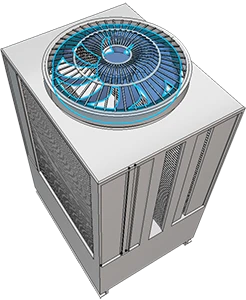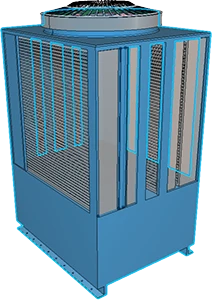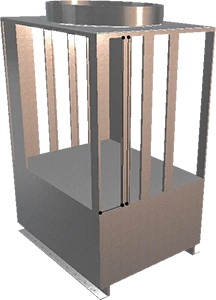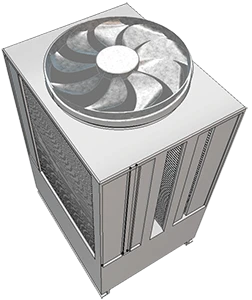To launch the experience, start by choosing the HVAC component you would like to assess


1/3 Select the raw material


Chromium Steel
The chromium steel 18/8 metal is composed of 68.6% Fe, 9.3% NI, 19% Cr and 0.08% C. Usage includes culinary utensils, surgical tools, medical equipment, architecture, automotive and aerospace applications.
Wrought Aluminum
A metal alloy with aluminum, derived from the treatment of aluminum scrap. Used for extrusion applications, electrical conductors, welding rods, sheeting, etc.
Recycled Polyethylene (PE)
High-density polyethylene (HDPE) recycled granulates used in manufacturing.




From Europe to Europe
Transporting of goods by freight over 1500 km, powered by diesel (16-32 metric ton lorry).
From China to Europe
Transporting of goods in container ships over 20,000 km, and by freight over 200 km, powered by diesel (16-32 metric ton lorry).
Energy Mix: Coal & Wind (dominant) + Nuclear
Electrical energy produced through hard coal power stations and 1-3MW onshore wind turbines, measured in kWh. These take into account the transmission infrastructure, country-specific and transformation losses.
→ 45.5% hard coal / 43.9% wind / 6.5% nuclear
Energy Mix: Nuclear (dominant) + Coal & Wind
Electrical energy produced through boiling water reactors, measured in kWh. This takes into account the transmission infrastructure, country-specific and transformation losses.
→ 70.4% nuclear / 20.6% wind / 9% hard coal
CO2 emissions
CO2 emissions
Quantifies the human emissions of greenhouse gases that cause environmental and social changes.
kg CO2
Land use
Land use
Corresponds to soil damage, ie., a mix between erosion resistance, mechanical filtration, physico-chemical filtration, groundwater regeneration and biotope.
Points
Fossil depletion
Fossil depletion
Depicts fossil fuel impact on resource depletion as energy carriers.
MJ
Minerals and metals depletion
Minerals and metals depletion
Represents abiotic resource depletion, quantified in kg of antimony-equivalent (Sb-eq) per g of extraction.
kg Sb
Water use
Water use
Characterizes water depletion according to scarcity-adjusted mass of water used.
m3 world deprived
Freshwater ecotoxicity
Freshwater ecotoxicity
The toxic effect on aquatic freshwater species, measured in Comparative Toxic Unit for ecosystems.
CTUe
Freshwater eutrophication
Freshwater eutrophication
The excessive growth of aquatic plants or algal blooms, due to high levels of nutrients in freshwater.
kg PO4
Acidification
Acidification
Mainly caused by air emissions of NH3, NO2 and SOx.
mol H+
Marine eutrophication
Marine eutrophication
One of the key local stressors for coastal marine ecosystems, particularly in locations with many estuaries.
kg N




Drilling Process for Chromium Steel
Applied for circular cavity or hole shapes, drilling is a conventional process where a rotating cutting tool is used to remove material from the work piece.
This manufacturing process is available for the loss of material. For this human activity, 1 kg of finished material represents 0.23 kg of losing material.
Milling Process for Chromium Steel
Used for complex shaping, milling is a chipping process where the piece of material is fixed to a movable table while the cutting energy is provided by the rotating cutting tool. Degreasing is not included.
The reference for milling is 1 kg of metal removed. Given the significant variation in LCI across different factories, it is advised that if this dataset plays a crucial role in the results, further investigation will be needed to determine the applicability of the rough estimations made. Weight = 2478 kg.
Injection Molding for Recycled PE
Discontinuous process in which plastic pellets, granules or powder is melted and injected under pressure into the cavity of a mold, before being solidified by cooling.
Thermoforming for Recycled PE
Stretching techniques of manufacture for 3D moldings from flat plastic preforms, under the influence of heat and pressure vacuum.
This process was selected among several other different processes in the manufacturing of the finished product.
Weight loss: 2478kg
Landfill for Wrought Aluminum
Generated from ordinary deposition transforming activities (sanitary landfill in the ecoinvent database), the waste aluminum is a solid industrial waste under the construction and demolition category, containing 100% waste aluminum (0% water on wet mass basis; 100% dry matter; no carbon content).
This is a non-hazardous waste.
Incineration for Wrought Aluminum
Generated from ordinary thermal transforming activities (municipal incineration in the ecoinvent database), scrap aluminum is a solid industrial waste under the construction and demolition category, containing 100% scrap aluminum (0% water on wet mass basis; 100% dry matter; no carbon content).
This is a non-hazardous waste.
Landfill for Recycled PE
Generated from ordinary deposition transforming activities (sanitary landfill in the ecoinvent database), Waste Polyethylene (PE) is a solid waste under the construction and demolition wastes category, containing 100% waste PE (0.4% water on wet mass basis; 99.6% dry matter).
This is a non-hazardous waste.
Incineration for Recycled PE
Generated from ordinary thermal transforming activities (municipal incineration in the ecoinvent database), Waste Polyethylene (PE) is a solid waste under the construction and demolition wastes category, containing 100% waste PE (0.4% water on wet mass basis; 99.6% dry matter).
This is a non-hazardous waste.
CO2 emissions
CO2 emissions
Quantifies the human emissions of greenhouse gases that cause environmental and social changes.
kg CO2
Land use
Land use
Corresponds to soil damage, ie., a mix between erosion resistance, mechanical filtration, physico-chemical filtration, groundwater regeneration and biotope.
Points
Fossil depletion
Fossil depletion
Depicts fossil fuel impact on resource depletion as energy carriers.
MJ
Minerals and metals depletion
Minerals and metals depletion
Represents abiotic resource depletion, quantified in kg of antimony-equivalent (Sb-eq) per g of extraction.
kg Sb
Water use
Water use
Characterizes water depletion according to scarcity-adjusted mass of water used.
m3 world deprived
Freshwater ecotoxicity
Freshwater ecotoxicity
The toxic effect on aquatic freshwater species, measured in Comparative Toxic Unit for ecosystems.
CTUe
Freshwater eutrophication
Freshwater eutrophication
The excessive growth of aquatic plants or algal blooms, due to high levels of nutrients in freshwater.
kg PO4
Acidification
Acidification
Mainly caused by air emissions of NH3, NO2 and SOx.
mol H+
Marine eutrophication
Marine eutrophication
One of the key local stressors for coastal marine ecosystems, particularly in locations with many estuaries.
kg N




CO2 emissions
CO2 emissions
Quantifies the human emissions of greenhouse gases that cause environmental and social changes.
kg CO2
Land use
Land use
Corresponds to soil damage, ie., a mix between erosion resistance, mechanical filtration, physico-chemical filtration, groundwater regeneration and biotope.
Points
Fossil depletion
Fossil depletion
Depicts fossil fuel impact on resource depletion as energy carriers.
MJ
Minerals and metals depletion
Minerals and metals depletion
Represents abiotic resource depletion, quantified in kg of antimony-equivalent (Sb-eq) per g of extraction.
kg Sb
Water use
Water use
Characterizes water depletion according to scarcity-adjusted mass of water used.
m3 world deprived
Freshwater ecotoxicity
Freshwater ecotoxicity
The toxic effect on aquatic freshwater species, measured in Comparative Toxic Unit for ecosystems.
CTUe
Freshwater eutrophication
Freshwater eutrophication
The excessive growth of aquatic plants or algal blooms, due to high levels of nutrients in freshwater.
kg PO4
Acidification
Acidification
Mainly caused by air emissions of NH3, NO2 and SOx.
mol H+
Marine eutrophication
Marine eutrophication
One of the key local stressors for coastal marine ecosystems, particularly in locations with many estuaries.
kg N